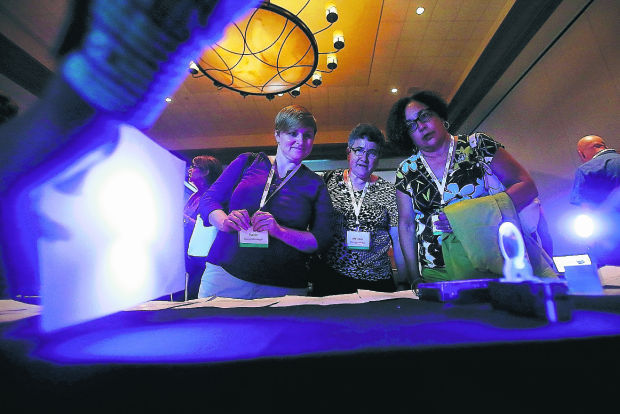The Optical Society, holding its 98th annual meeting in Tucson this week, is bullish on the potential for integrating photonic devices into all aspects of American manufacturing, boosted by the announcement of a $100 million-plus federal plan to speed development of photonics manufacturing.
It’s very good news for the industry and potentially for Tucson and the region, said Bob Breault, who has led development of “optics clusters” across the country and the world.
Breault, president of Tucson-based Breault Research Organization, said the $100 million match required to lure the manufacturing facility would be tough to put together locally. “If you’re going to have to match $100 million, you’re not going to do it in this state,” he said.
“We could get a piece of it. I’d be very disappointed if Arizona and Tucson … were not involved.”
“We need to be involved and get the university involved and get Raytheon involved and do some sub-bidding if not primary bidding,” Breault said.
Thomas L. Koch, dean of the University of Arizona College of Optical Sciences, said the college had been intimately involved in “putting together the concept for it.”
“I’m not envisioning we’re ground-zero, but we certainly have a strong say,” he said.
He said the UA is working with optics companies and other universities “about how to accomplish the goals of the program.”
President Obama announced earlier this month that photonics had been selected as the latest of his initiatives to foster growth of American manufacturing. The Integrated Photonics Manufacturing Institute would pair $100 million in Department of Defense contracts with public and private investments.
“It’s a quarter-billion-dollar project,” said Alan Willner, vice president of the Optical Society, and that’s just for starters. “Other agencies will bring in money to help as well. This thing has the potential to mushroom,” he said.
Willner is a professor of electrical engineering at University of Southern California, and one of the authors of a National Academy of Sciences report that recommended federal investment in photonics manufacturing.
The goal, he said, is to give optical devices, which use light or photons rather than electrons, the same plug-and-play capabilities as electronic devices.
“It’s an ecosystem. It’s not just to fabricate something, but fabricate it and package it and make it useful so that people can design something and you can plug it in,” he said.
The institute would take on problems that are commonly shared by optics manufacturers, such as standards, testing and manufacturing techniques.
Researchers and start-up optics companies have come up with all manner of ways to incorporate light into devices that now use electronics for things such as switches and sensors.
The problem for industry and for the Department of Defense is getting them to market, said Tom Hausken, senior industry adviser for the Optical Society.
“There is this infamous ‘valley of death,’ ” he said, caused by a gap in investment capital. “You need new investment. This is not the flavor of the month for the VC (venture capital) community.”
Willner said the new facility will aid optics companies regardless of where it is situated.
“Certainly, Arizona is well-positioned to be very competitive on many different levels,” he said, citing its optics industry and the research strength of the College of Optical Sciences.
Breault said Arizona will have “a competitive role, I won’t say an advantage, because we have a big aerospace industry, a wonderful bio-optics community. We have more vital, gutty-at-the-grassroots-level R and D.”
The process for awarding the grants begins in two weeks with an expected “broad area announcement” from the Department of Defense, said Hausken.
The first round of proposals will produce a “sketch” of what the bidders seek to accomplish, he said, followed by a round in which finalists will fine-tune their plans.
Koch said the “sweet spot” is finding a way to link optical devices “very intimately with manufacturing techniques for electronics.”
The 2012 National Academy report, “Optics and Photonics: Essential Technologies for our Nation,” established that goal.
“Chip-level integration will reduce weight and increase speed while reducing cost, thus opening up a large set of future possibilities as devices become further miniaturized,” the report said.
On Monday, the Optical Society conference, “Frontiers in Optics,” honored Bob Breault with the Robert E. Hopkins Leadership Award, as a “pioneer in the field of computerized stray-light analysis” and for his work in “regional, national and global development” with the creation of dozens of optics clusters.





